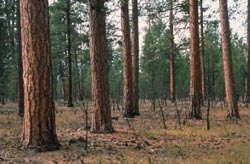Earth and Sky:Fire Cycle 火灾规律(在线收听)

Fire Cycle 火灾规律
The El Nino phenomenon of 1997-98 unleashed torrential rain in some parts of the world, while creating abnormally dry conditions in others. And it sparked record numbers of wildfires. Learn more about climate and wildfire -- today on Earth and Sky.
JB: This is Earth and Sky. We spoke with fire expert Steve Pyne of Arizona State University in Tempe -- about fire and climate, the long term pattern of weather.
Steve Pyne: Climate is of course one of the fundamental shapers of fire. The ideal climate for fire is a pattern of wetting and drying. That is to say, what you want to know is how frequent, and how intense are the wet and dry spells. So, many places go through a wetting and drying cycle every year, which is to say they have an annual fire cycle. So, it has to be wet enough to grow stuff, and then dry enough to prepare it to burn.
DB: For example, desert fires are more frequent after unusually wet seasons -- such as during an El Nino year -- because more plants spring up.
Steve Pyne: The biggest fire seasons are those that are dry after a period of wet runs. So you've had several years to build up everything, now it suddenly turns dry and you're ready to burn. Or places where there is a very violent fluctuation, places that are normally very wet, suddenly and unexpectedly turn dry. Places that are very dry suddenly become flush with water, and all kinds of ephemerals and such sprout up.
DB: So fire and climate are linked. Special thanks today to the Bureau of Land Management and to the National Fish and Wildlife Foundation -- supporting the conservation of native fish, wildlife, plants and their habitats. I'm Deborah Byrd for Earth and Sky.